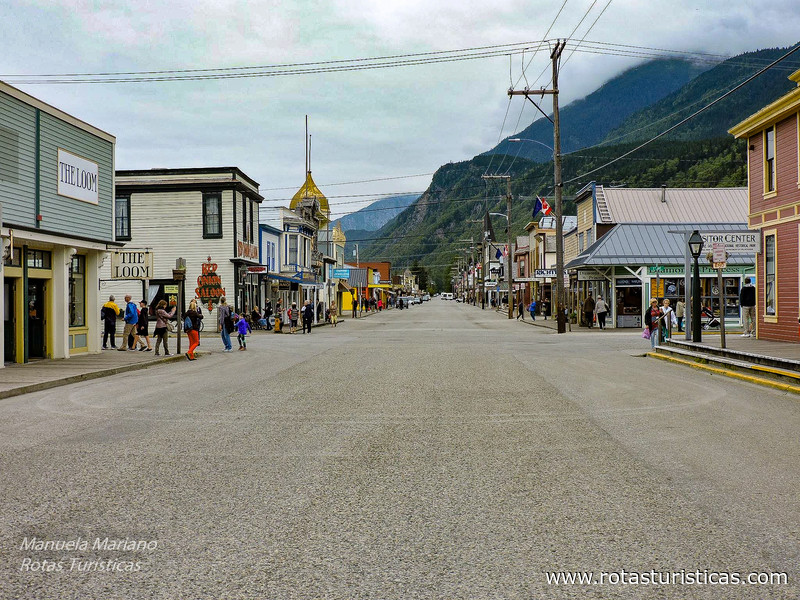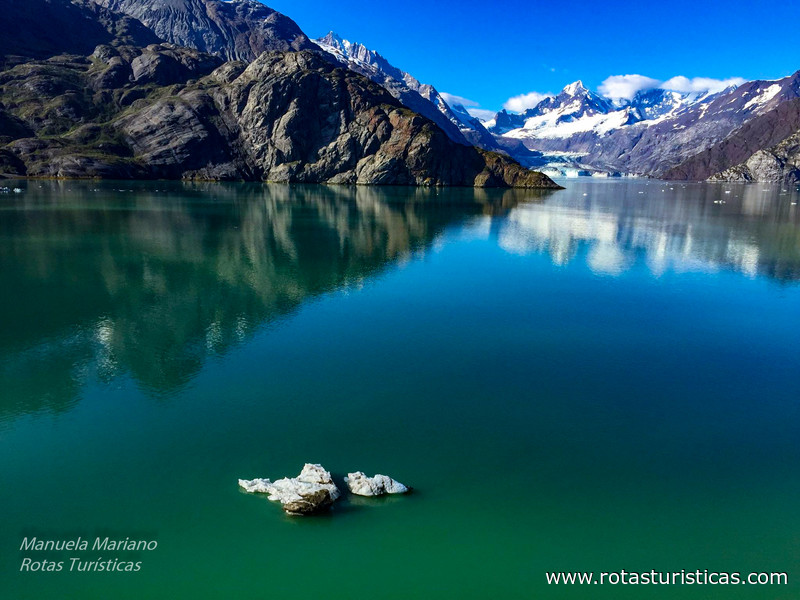Pictures of: Alaska
Location map
Airports
Hotels and other Accommodation
Golf Courses
What to visit
World Nomads
The Travel Insurance with the largest coverage

The Travel Insurance with the largest coverage

Alaska
Alaska is one of the 50 states of the United States and the largest in territorial extent, being larger than the American states of Texas, California and Montana together (respectively the second, third, and fourth largest). Alaska is also the most sparsely populated state in the United States, with a population density of 0.42 inhab / km², the lowest among all 50. Alaska has fewer inhabitants than any American state except for Wyoming, North Dakota and Vermont. If it were an independent country, Alaska would be the 17th largest country in the world in territorial extension. Relatively isolated from the rest of the country, Alaska is considered part of the Pacific States.
Tourism
With imposing scenic beauty, huge Ice Age glaciers and wild life in profusion, no other place on Earth is the same as Alaska. You will find a wide variety of activities in Alaska, from mild to wild. No matter your choice: traveling to Alaska is pure fun!
Wildlife Viewing
For wildlife watching, Alaska is the place to be. American eagles flock to the hundreds, moose cause traffic jams in the streets and millions of salmon spawn in their rivers. Take a guided tour of a national park or wildlife refuge to see moose and caribou, or a boat trip to see otters, whales and dolphins. No matter where you are, you will find an incredible variety of wildlife.
Take a breathtaking car tour
Driving in Alaska is an unforgettable experience. Spectacular views, pristine lakes and towering mountains are all part of the driving experience in Alaska. In search of adventure? Fly to Alaska and rent a car or trailer. You will find 3 routes certified as National Scenic Byways; the Seward and Glenn Highways, and the Alaska Marine Road, an exclusive ferry route that connects 3,500 miles of coastal waterways.
Visit the largest national park in the country
Alaska is home to 17 national park areas, and that means two-thirds of the territory in the national park system as a whole. From mountain ranges and volcanoes to wild rivers and the vast tundra, Alaska's parks offer a host of opportunities for tourism and fun. Visit Wrangell-St. Elias, the largest national park in the United States and see the best example of what remains of a copper mining town of the twentieth century.
Wildlife Viewing
For wildlife watching, Alaska is the place to be. American eagles flock to the hundreds, moose cause traffic jams in the streets and millions of salmon spawn in their rivers. Take a guided tour of a national park or wildlife refuge to see moose and caribou, or a boat trip to see otters, whales and dolphins. No matter where you are, you will find an incredible variety of wildlife.
Take a breathtaking car tour
Driving in Alaska is an unforgettable experience. Spectacular views, pristine lakes and towering mountains are all part of the driving experience in Alaska. In search of adventure? Fly to Alaska and rent a car or trailer. You will find 3 routes certified as National Scenic Byways; the Seward and Glenn Highways, and the Alaska Marine Road, an exclusive ferry route that connects 3,500 miles of coastal waterways.
Visit the largest national park in the country
Alaska is home to 17 national park areas, and that means two-thirds of the territory in the national park system as a whole. From mountain ranges and volcanoes to wild rivers and the vast tundra, Alaska's parks offer a host of opportunities for tourism and fun. Visit Wrangell-St. Elias, the largest national park in the United States and see the best example of what remains of a copper mining town of the twentieth century.
Gastronomy
The food in Alaska is characterized by being fish-based, with salmon being the most famous. Typical meals may contain different seafood. Other species that are taking value among Alaskan foods are trout, herring and crabs. One of his most recognized dishes is the fish soup, a very thick cream, made with grouper, shrimp, clams and salmon. Definitely a dish that will keep you satisfied for the rest of the day.
To counteract the effects of climate, most fried foods are consumed in Alaska. Breakfast can consist of fried fish, eggs and chips. Other key meats in Alaskan cuisine are game, deer, moose and poultry.
Among other typical dishes of the country, you can find salmon or grilled or fried trout, breaded steaks is also a common way to prepare them for frying. The Akutaq is a dish made with berries and meat seasoned with sugar, ribs in tomato sauce, beans and salad. The dishes are more than convincing.
To accompany meals, you can drink the local beer or try a type of wine made with leaves of plants called cemenerio.
To counteract the effects of climate, most fried foods are consumed in Alaska. Breakfast can consist of fried fish, eggs and chips. Other key meats in Alaskan cuisine are game, deer, moose and poultry.
Among other typical dishes of the country, you can find salmon or grilled or fried trout, breaded steaks is also a common way to prepare them for frying. The Akutaq is a dish made with berries and meat seasoned with sugar, ribs in tomato sauce, beans and salad. The dishes are more than convincing.
To accompany meals, you can drink the local beer or try a type of wine made with leaves of plants called cemenerio.
Climate
The region is famous worldwide for its stereotype of having a polar climate, cold all year round. However, due to its great extension, it has different climates, which vary from region to region. In general, it has long, cold winters, whose nights are very long, and mild and short summers, with very long days.
The north has the lowest temperatures throughout the United States. The north of the state has a polar climate. The average temperature in winter is -24 ° C in winter and 8 ° C in summer. Minima can easily reach -50 ° C, and maximums hardly exceed 15 ° C.
The central and western regions have a temperate climate, with lower temperatures in winter and higher in the summer than in the south, presenting averages of -22 ° C in winter and 16 ° C in summer.
The southern end, along the coastline of the state with the Pacific Ocean, has a temperate climate, whose winters are tempered by the warm ocean currents of the Pacific and the gentle air currents from Japan. In the south, the average temperature in winter is -2 ° C, and in summer, 13 ° C. Minima vary between -45 ° C in winter and 35 ° C in summer. The highest temperature ever recorded in the state is 38 ° C, recorded on June 27, 1915.
The average annual precipitation rates of rainfall in the state varies greatly from region to region. The southern region of Alaska has an average annual average ranging from 80 to 240 (with certain regions receiving more than 500 centimeters of annual average rainfall), thanks to the Rocky Mountains that act as natural obstacles to moist air currents in the Pacific . The rest of the state has a very dry climate. Northern Alaska receives less than 40 cm of precipitation, with the northern region receiving only 15 cm per year. The average annual rainfall rates for snow ranges from 130 cm (south) to 30 cm (west).
The north has the lowest temperatures throughout the United States. The north of the state has a polar climate. The average temperature in winter is -24 ° C in winter and 8 ° C in summer. Minima can easily reach -50 ° C, and maximums hardly exceed 15 ° C.
The central and western regions have a temperate climate, with lower temperatures in winter and higher in the summer than in the south, presenting averages of -22 ° C in winter and 16 ° C in summer.
The southern end, along the coastline of the state with the Pacific Ocean, has a temperate climate, whose winters are tempered by the warm ocean currents of the Pacific and the gentle air currents from Japan. In the south, the average temperature in winter is -2 ° C, and in summer, 13 ° C. Minima vary between -45 ° C in winter and 35 ° C in summer. The highest temperature ever recorded in the state is 38 ° C, recorded on June 27, 1915.
The average annual precipitation rates of rainfall in the state varies greatly from region to region. The southern region of Alaska has an average annual average ranging from 80 to 240 (with certain regions receiving more than 500 centimeters of annual average rainfall), thanks to the Rocky Mountains that act as natural obstacles to moist air currents in the Pacific . The rest of the state has a very dry climate. Northern Alaska receives less than 40 cm of precipitation, with the northern region receiving only 15 cm per year. The average annual rainfall rates for snow ranges from 130 cm (south) to 30 cm (west).
Other tourist destinations in:
USA
USA
Other world tourist destinations
Why to book with
The best prices
Our partnerships with the world´s largest operators offer research on the best market prices.
More options
At Rotas Turisticos you can book the hotel, buy the air ticket, book the transfer from the airport to the hotel and vice versa, book the local excursions, rent the car, take travel insurance and consult the places to visit and where to go.
Holiday Tips & Destinations
Hundreds of holiday destinations with all the options that allow you to easily choose the destination that best suits your dream vacation.
Links












